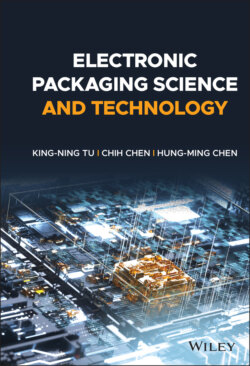Читать книгу Electronic Packaging Science and Technology - King-Ning Tu - Страница 10
1 Introduction 1.1 Introduction
ОглавлениеAs we enter the big data era, mobile devices are ubiquitous. On hardware, nearly everyone has a cell phone. On software, internet of things (IOT) reaches everywhere. We have man‐to‐man, man‐to‐machine, and machine‐to‐machine communications. Furthermore, during the Covid‐19 virus pandemic, the trend of distance teaching, distance medicine, home office, and online meeting has increased greatly the need of advanced consumer electronic products, demanding smaller form factor, larger memory, more function, cheaper cost, faster and greater rate of data transmission, and superb reliability. Actually, the advanced 5G communication technology and 3‐dimensional integration of circuits (3D IC) have already begun their impact to our society. No doubt the world around us is changing rapidly. In human history, this is the second time of a fundamental revolution.
In eighteenth century, we had industrial revolution when steam engine was invented. It developed machine power to replace human power and animal power. The activities in civilization were changing from agriculture to industry. We had railroad trains, ocean liners, automobiles, airplanes, and electricity. While industrial production has transformed human society from feudal to democratic, it was accompanied by capitalism, then communism, and then socialism. Indeed, the impact to human society was huge in the last two to three hundred years.
In twentieth century, after the invention of transistor, very‐large‐scale integration of transistor circuits, and mobile technology, we have data power to enhance machine power. What is coming is to have artificial intelligence (AI) revolution. We have robots, and human‐less vehicles and aircrafts to serve us. Mobile technology supported by mobile internet will have a long way to go in the near future. Accompanying the rapid progress, however, Moore’s law of miniaturization in Si chip technology is near ending, so people wonder whether the rapid progress can be sustained.
If we look back to the last 10–20 years, semiconductor industry has had some interesting events. Namely, Japan has lost the leadership in semiconductor technology. The large European countries such as England, France, and Russia have no presence in microelectronics. On the other hand, Taiwan and Korea have gained the leadership due to the success of Taiwan Semiconductor Manufacturing Corporation (TSMC) and Samsung. Today, China has identified semiconductor device development and manufacturing to be a national goal and will spend a large sum of money to achieve it. One of the key reasons behind the trade war between United States and China is due to the competition in advanced semiconductor technology and in manufacturing of consumer electronic products. At the same time, 5G communication technology and AI applications are with us and they exert an unlimited impact and change to our society.
There were many reasons of Japan’s failure, such as the critical change in currency exchange rate between yuan and dollar, and also the heavy punishments of Fujitsu by United States. However, Japan has recently joined TSMC to form an advanced electronic packaging factory in Japan to maintain its impact. The weaker and weaker presence of England and France is because of the insufficient financial support on semiconductor technology due to socialism. They tended to support rather uniformly the popular needs of society, but did not concentrate on supporting semiconductor technology. Today, to build a Si‐based transistor factory will take 3–5 billion US dollars, so fewer and fewer countries can afford it. Russia is simply poor. Samsung in Korea has had the government’s focused support to do so. TSMC in Taiwan is unique that it takes orders from all over the world to make VLSI devices, so it knows the major trend of the technology. Thus, it can spend the money it earned to keep improving the technology with innovation. For example, the technique of immersion lithography has enabled TSMC to lead the manufacturing of nanoscale semiconductor devices for the past five generations. Now, we are having the 5 nm node of nanotechnology, and 3 nm and 2 nm nodes are coming.
Some experts in China commented that China might take 10 years to catch up. No reason was given why it will take so long! On the other hand, China has been very successful in high‐speed train and satellite technology. When China can make transistors as cheap as those made in United States, it is a sign that China has caught up. A plausible reason is given below.
A Chinese classic philosopher, Wang Yang‐Ming, said “Knowing is hard, but practice is easy.” Semiconductor technology is completely opposite that “Knowing is easy, but practice is hard.” Take an example of teaching a child to play violin or piano; we can find the best teacher to teach the child all the technique and tricks of how to play well. Even a very talented child, he/she still has to take 10–20 years of practice to be good. It is the “experience” that is needed to do well. Indeed, “experience” cannot be taught quickly and cannot be copied or cannot be steal. Furthermore, in semiconductor manufacturing, the experience is not just of one person, it is of an entire industry.
